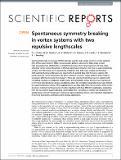| dc.contributor.author | Curran, P. J. | |
| dc.contributor.author | Desoky, W. M. | |
| dc.contributor.author | Chaves, A. | |
| dc.contributor.author | Bending, S. J. | |
| dc.contributor.author | Milosevic, M. V. | |
| dc.contributor.author | Moodera, Jagadeesh | |
| dc.contributor.author | Laloe, Jean-Baptiste | |
| dc.date.accessioned | 2015-12-23T16:32:53Z | |
| dc.date.available | 2015-12-23T16:32:53Z | |
| dc.date.issued | 2015-10 | |
| dc.date.submitted | 2015-07 | |
| dc.identifier.issn | 2045-2322 | |
| dc.identifier.uri | http://hdl.handle.net/1721.1/100501 | |
| dc.description.abstract | Scanning Hall probe microscopy (SHPM) has been used to study vortex structures in thin epitaxial films of the superconductor MgB[subscript 2]. Unusual vortex patterns observed in MgB[subscript 2] single crystals have previously been attributed to a competition between short-range repulsive and long-range attractive vortex-vortex interactions in this two band superconductor; the type 1.5 superconductivity scenario. Our films have much higher levels of disorder than bulk single crystals and therefore both superconducting condensates are expected to be pushed deep into the type 2 regime with purely repulsive vortex interactions. We observe broken symmetry vortex patterns at low fields in all samples after field-cooling from above T[subscript c]. These are consistent with those seen in systems with competing repulsions on disparate length scales, and remarkably similar structures are reproduced in dirty two band Ginzburg-Landau calculations, where the simulation parameters have been defined by experimental observations. This suggests that in our dirty MgB[subscript 2] films, the symmetry of the vortex structures is broken by the presence of vortex repulsions with two different lengthscales, originating from the two distinct superconducting condensates. This represents an entirely new mechanism for spontaneous symmetry breaking in systems of superconducting vortices, with important implications for pinning phenomena and high current density applications. | en_US |
| dc.description.sponsorship | United States. Office of Naval Research (Grant N00014-06-01-0235) | en_US |
| dc.language.iso | en_US | |
| dc.publisher | Nature Publishing Group | en_US |
| dc.relation.isversionof | http://dx.doi.org/10.1038/srep15569 | en_US |
| dc.rights | Creative Commons Attribution | en_US |
| dc.rights.uri | http://creativecommons.org/licenses/by/4.0/ | en_US |
| dc.source | Nature Publishing Group | en_US |
| dc.title | Spontaneous symmetry breaking in vortex systems with two repulsive lengthscales | en_US |
| dc.type | Article | en_US |
| dc.identifier.citation | Curran, P. J., W. M. Desoky, M. V. Milosevic, A. Chaves, J.-B. Laloe, J. S. Moodera, and S. J. Bending. “Spontaneous Symmetry Breaking in Vortex Systems with Two Repulsive Lengthscales.” Scientific Reports 5 (October 23, 2015): 15569. | en_US |
| dc.contributor.department | Massachusetts Institute of Technology. Department of Physics | en_US |
| dc.contributor.department | Francis Bitter Magnet Laboratory (Massachusetts Institute of Technology) | en_US |
| dc.contributor.mitauthor | Laloe, J.-B. | en_US |
| dc.contributor.mitauthor | Moodera, Jagadeesh | en_US |
| dc.relation.journal | Scientific Reports | en_US |
| dc.eprint.version | Final published version | en_US |
| dc.type.uri | http://purl.org/eprint/type/JournalArticle | en_US |
| eprint.status | http://purl.org/eprint/status/PeerReviewed | en_US |
| dspace.orderedauthors | Curran, P. J.; Desoky, W. M.; Milos̆ević, M. V.; Chaves, A.; Laloë, J.-B.; Moodera, J. S.; Bending, S. J. | en_US |
| dc.identifier.orcid | https://orcid.org/0000-0002-2480-1211 | |
| mit.license | PUBLISHER_CC | en_US |
| mit.metadata.status | Complete | |
